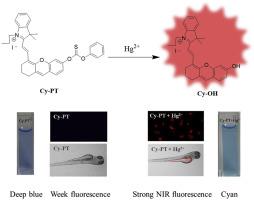Dyes and Pigments ( IF 4.1 ) Pub Date : 2020-07-30 , DOI: 10.1016/j.dyepig.2020.108674 Gang Yuan , Hehong Lv , Heng Liu , Hanping He , Qi Sun , Xiuhua Zhang , Shengfu wang

|
Herein, a novel near-infrared fluorescent probe (Cy-PT) for the detection of Hg2+ was designed and synthesized, which contained a hemicyanine skeleton as the near-infrared (NIR) fluorophore and carbonothioate moiety as the recognition unit. The very weak fluorescence of Cy-PT is greatly enhanced due to the destruction of thiocarbonate moiety by Hg2+, generating a hydroxyl group. The study shows that Cy-PT exhibits many advantages including NIR emission (708 nm), colorimetric change, off-on fluorescence, remarkably large Stokes shift (120 nm), rapid response, excellent sensitivity and high selectivity. In addition, Cy-PT can be used as a direct visualization detector for Hg2+ detection, allowing further application using test paper. Subsequent fluorescence imaging shows that Cy-PT probe has high ability to enter living cells and bodies, generating strong NIR fluorescence response in the presence of Hg2+. This study indicates that Cy-PT probe is a good candidate for Hg2+ detection in colorimetric and near-infrared fluorescence, which can be developed into an efficient method for Hg2+ detection in complex living samples.
中文翻译:

基于半花菁的比色和近红外荧光关闭探针,用于活细胞和斑马鱼中的Hg 2+检测和成像
在此,设计并合成了一种新型的用于检测Hg 2+的近红外荧光探针(Cy-PT),该探针包含半花菁骨架作为近红外(NIR)荧光团,并含有碳硫键部分作为识别单元。Cy-PT的非常弱的荧光由于Hg 2+破坏了硫代碳酸盐部分而大大增强了,产生羟基。研究表明,Cy-PT具有许多优点,包括近红外发射(708 nm),比色变化,截止荧光,斯托克斯频移(120 nm)非常大,快速响应,出色的灵敏度和高选择性。此外,Cy-PT可用作Hg2 +检测的直接可视化检测器,从而允许使用试纸进一步应用。随后的荧光成像显示,Cy-PT探针具有进入活细胞和体内的高能力,在Hg 2+存在下产生强大的NIR荧光响应。这项研究表明,Cy-PT探针是比色和近红外荧光检测Hg 2+的良好候选者,可以发展成为检测Hg 2+的有效方法。 检测复杂的活体样品。





















































 京公网安备 11010802027423号
京公网安备 11010802027423号